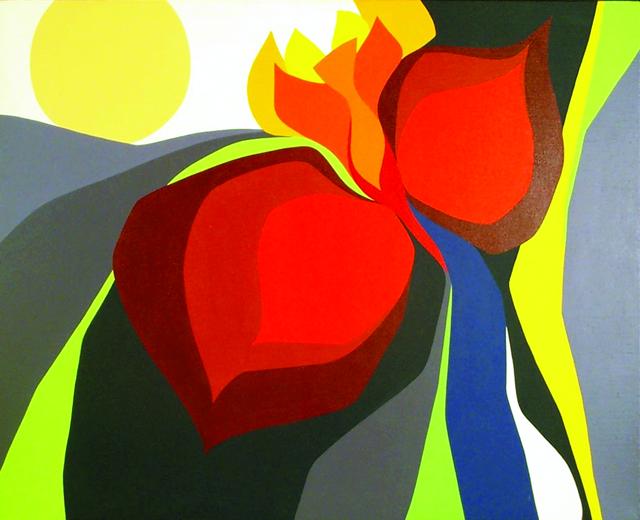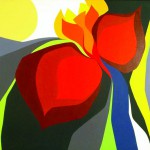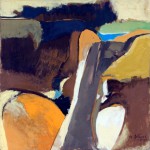- A great primer to color: David Appleman’s “Summer Sunrise,” acrylic on canvas. Photos courtesy Asheville Art Museum
- Maud Gatewood’s “Lake Road,” oil on canvas.
If one says “red” (the name of the color)
and there are 50 people listening
it can be expected that there will be 50 reds in their minds.
And one can be sure that all these reds will be very different.
— Josef Albers, The Interaction of Color
After huffing it up the stairs to the third floor of the Asheville Art Museum, I was immediately absorbed into a sea of blue canvas — Kenneth Noland’s “North South East West.” The blue — calm, deep and mysterious — beckons the viewer, as an ocean at dusk, to plunge into its comforting waters. The painting is breathtaking and is a brilliant introduction to the Asheville Art Museums latest exhibition, Color Study.
From Noland’s piece, my eye wandered eastward on the wall to “Chance of Flurries,” a stained and stitched piece by local artist Nava Lubelski. Considering the contemporary concepts behind Lubelski’s work, it is somewhat strange to see her piece presented alongside a color field painting, but oh well.
Because of the context of the show, I note the colors Lubelski uses — a canvas of pale blue and grey, with black, cream and royal blue stitches; webbing and knots meander through it, accentuating a lone red dot. It is dazzling to think she did all this by hand, but that is a digression from the original notion of the exhibit: color.
Next is a study in color-depth, “Jabd,” made with a spray gun by Jules Olitski in 1965. Beside that hangs a painting in pastel hues, “Parallel Variation,” by Gayle Paul, and a majestic piece by Daniel Nevins, “Number 7,” in which opposing yellow-and-blue planes hold dark psychedelic bouquets that emphasize Nevins’ luscious palette.
This is the point of the exhibit where I start getting confused, and the next piece, “Wall Circle” — an experiment with unstretched canvas by Sam Gilliam — seals the deal. Roaming from one generation of artists to the next, from one genre into the next, dilutes the overall concept of the show. It seems to be more a study in nonrepresentational artwork than a study in color.
The curator’s statement reads, “The works in this exhibition use color as their primary means of expression. Whatever their stance on these issues, the artists in Color Study all share a steadfast devotion to the exploration of color.” I’m not so sure. Only the pieces by the actual color theorists and color-field painters, such as Noland, W. P. Jennerjahn and George Lee Bireland, use color as their primary means of expression.
Not that the other paintings are bad. On the contrary, most are quite spectacular. I’m just not convinced that color was the motivational factor behind their inception. Certainly all the pieces utilize color in some way, but to connect them with this thread seems arbitrary.
I opted to navigate the show with Josef Albers’ teachings as my guide. A pioneering theorist on color, Albers’ book, Interaction of Color, puts forth that color is the most relative element in art. Everyone sees color differently and attaches different meaning to it. The colors themselves appear different according to their surroundings and the light cast upon them. From this perspective, I can appreciate such paintings as Julian Stanczak’s “Flirtation Cerise,” which vibrates with varied lavender hues and orange squares, or Joseph Fiore’s gestural “Blue” painting.
A painting by Oli Sihvonen, “Untitled,” also stands out. The use of blues and reds on one half, and oranges and purples on the other, creates tension in spite of their orderly arrangement. It recalls a mass of differing personalities, tightly arranged in a linear format that begs for visual release.
Overall, Color Study includes some very impressive work, and I commend the curator for including paintings by local artists, which is rare for exhibits at The Asheville Art Museum. For those who have never thought about color and its use in art, Color Study is a great primer.
After visiting the exhibit again, it seems clear that the curator chose to group artists according to their respective palettes. Unfortunately, for a show that claims to be all about color, the works of the color vanguard run the risk of being overlooked when presented alongside contemporary pieces that demonstrate more conceptual or gestural elements.
Color Study will be up through Nov. 6 in the Appleby Foundation Gallery. Get more information at ashevilleart.org.
— Ursula Gullow writes about art for Mountain Xpress and her blog, artseenasheville.blogspot.com.






“Overall, Color Study includes some very impressive work, and I commend the curator for including paintings by local artists, which is rare for exhibits at The Asheville Art Museum.”
I would like to amend this comment by pointing out that The Asheville Art Museum has done a considerable job of including prominent regional craft artists and photographers in their permanent exhibits and gift shop. Last year, for example, the photographs of Tim Barnwell were exhibited and currently there is an extensive collection of Appalachian and Cherokee basketry on display.
Regarding their larger exhibits, however, I still believe there is a dearth of local (and international) contemporary and conceptual visual art represented. I hope Color Study is the first of more exhibitions that include relevant work by local artists reflecting current trends and concepts in art making.
“. . ., I still believe there is a dearth of local (and international) contemporary and conceptual visual art represented.”
Perhaps there is no “international” art represented because the Asheville Art Museum is specifically devoted to American art of the 20th and 21st century. Thanks to Ms. Gullow for acknowledging the museum’s efforts to represent local craft artists and photographers. Perhaps Ms. Gullow could do an article on Asheville and Western North Carolina artists who are represented in the museum’s permanent collection and what criteria the museum uses in making these choices.
wow… this is awesome